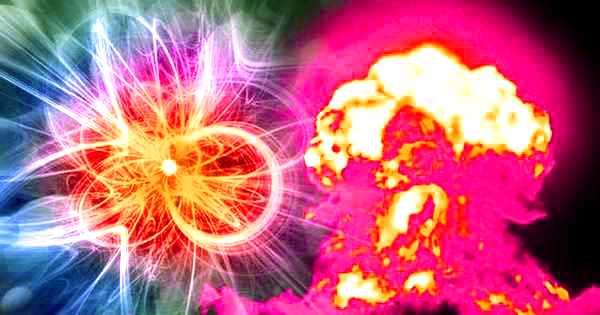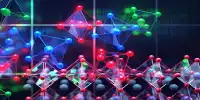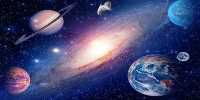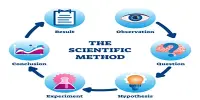Scientists studying particle collisions at the Relativistic Heavy Ion Collider (RHIC), a user facility for nuclear physics research at the US Department of Energy’s Brookhaven National Laboratory, have produced definitive evidence for two physics phenomena predicted more than 80 years ago. The findings, which are published in Physical Review Letters, were derived from a detailed analysis of over 6,000 pairs of electrons and positrons produced in glancing particle collisions at RHIC.
The main discovery is that pairs of electrons and positrons – matter and antimatter particles – can be directly created by colliding very energetic photons, which are quantum “packets” of light. This transformation of energetic light to matter is a direct result of Einstein’s famous E=mc2 equation, which states that energy and matter (or mass) are interchangeable. Nuclear reactions in the sun and at nuclear power plants convert matter into energy on a regular basis. Light energy has now been converted directly into the matter by scientists in a single step.
The second result demonstrates that, depending on how light is polarized, the path of light traveling through a magnetic field in a vacuum bends differently. When light passes through certain materials, it experiences polarization-dependent deflection (also known as birefringence). (This is similar to how wavelength-dependent deflection divides white light into rainbows.) However, this is the first time polarization-dependent light-bending has been demonstrated in a vacuum.
Both results are dependent on RHIC’s STAR detector’s ability to measure the angular distribution of particles produced in glancing collisions of gold ions moving at nearly the speed of light.
Scientists studying particle collisions have produced definitive evidence for two physics phenomena predicted more than 80 years ago: that matter/antimatter can be created directly by colliding photons and that a magnetic field can bend polarized light along different paths in a vacuum.
Colliding clouds of photons
When physicists Gregory Breit and John A. Wheeler first described the hypothetical possibility of colliding light particles to create pairs of electrons and their antimatter counterparts, known as positrons, in 1934, such capabilities did not exist.
“Breit and Wheeler realized this is almost impossible to do in their paper,” said Brookhaven Lab physicist Zhangbu Xu, a member of RHIC’s STAR Collaboration. “Lasers did not even exist at the time! Breit and Wheeler, on the other hand, proposed an alternative: accelerating heavy ions. And their alternative is exactly what RHIC is doing.”
An ion is essentially an atom that has been stripped of its electrons. A gold ion has 79 protons and a strong positive charge. Accelerating a charged heavy ion to extremely high speeds creates a powerful magnetic field that spirals around the speeding particle as it travels, similar to current flowing through a wire.
“If the speed is high enough,” Xu says, “the strength of the circular magnetic field can be equal to the strength of the perpendicular electric field.” And a photon is a quantized “particle” of light, consisting of perpendicular electric and magnetic fields of equal strength. “As the ions approach the speed of light, there are a swarm of photons surrounding the gold nucleus, traveling with it like a cloud.”
In two accelerator rings at RHIC, scientists accelerate gold ions to 99.995 percent of the speed of light. “We have two clouds of photons moving in opposite directions with enough energy and intensity that those photon fields can interact when the two ions graze past each other without colliding,” Xu explained.

The STAR physicists observed the interactions and searched for the predicted electron-positron pairs. However, such particle pairs can be created at RHIC through a variety of processes, including “virtual” photons, a state of photon that exists briefly and carries an effective mass. To be certain that the matter-antimatter pairs were generated by real photons, scientists must show that the contribution of “virtual” photons has no effect on the experiment’s outcome.
To accomplish this, the STAR researchers examined the angular distribution patterns of each electron in relation to its partner positron. These patterns differ for pairs produced by real photon interactions versus pairs produced by virtual photon interactions.
“We also measured the systems’ energy, mass distributions, and quantum numbers. They agree with theoretical calculations of what would happen with real photons “said Daniel Brandenburg, a Goldhaber Fellow at Brookhaven Lab who worked on this discovery by analyzing STAR data.
Other researchers have attempted to create electron-positron pairs through light collisions using powerful lasers – focused beams of intense light. However, the individual photons within those intense beams do not yet have enough energy, according to Brandenburg.
In 1997, a nonlinear process was used to successfully complete an experiment at the SLAC National Accelerator Laboratory. The energy of photons in one laser beam had to be increased first by colliding it with a powerful electron beam, according to scientists. Collisions of boosted photons with multiple photons at the same time produced matter and antimatter in an enormous electromagnetic field created by another laser.
“Our findings provide clear evidence of direct, one-step creation of matter-antimatter pairs from light collisions, as predicted by Breit and Wheeler,” said Brandenburg. “With RHIC’s high-energy heavy-ion beam and the STAR detector’s large acceptance and precision measurements, we can analyze all the kinematic distributions with high statistics to determine that the experimental results are indeed consistent with real photon collisions.”
Bending light in a vacuum
The ability of STAR to measure the tiny deflections of electrons and positrons produced almost simultaneously in these events also provided physicists with a method to study how light particles interact with the powerful magnetic fields generated by the accelerated ions.
“The cloud of photons surrounding the gold ions in one of RHIC’s beams is shooting into the strong circular magnetic field produced by the accelerated ions in the other gold beam,” explained Chi Yang, a long-time STAR collaborator from Shandong University who has spent his entire career studying electron-positron pairs produced by various RHIC processes. “We can tell how polarized light interacts with the magnetic field by looking at the distribution of particles that come out.”
Werner Heisenberg and Hans Heinrich Euler predicted in 1936, and John Toll predicted in the 1950s, that a vacuum of empty space could be polarized by a powerful magnetic field, and that such a polarized vacuum would deflect photon paths depending on photon polarization. Toll’s thesis also explained how light absorption by a magnetic field is affected by polarization and how it relates to the refractive index of light in a vacuum. This polarization-dependent deflection, known as birefringence, has been observed in a wide range of crystals. There was also a recent report of light from a neutron star bending in this direction, presumably due to interactions with the star’s magnetic field. But no Earth-based experiment has detected birefringence in a vacuum.
The scientists at RHIC observed how the polarization of the light affected whether it was “absorbed” by the magnetic field. According to Yang, this is similar to how polarized sunglasses prevent certain rays from passing through if they do not match the polarization of the lenses. In the case of the sunglasses, you could, in theory, measure an increase in the temperature of the lens material as it absorbs the energy of the blocked light in addition to seeing less light pass through. The absorbed light energy is what creates the electron-positron pairs at RHIC.
“When we examine the products of photon-photon interactions at RHIC, we notice that the angular distribution of the products is affected by the angle of polarization of the light. This means that the absorption (or passing) of light is affected by its polarization “Yang stated. This is the first time that polarization has been observed to affect the interactions of light with the magnetic field in the vacuum – the vacuum birefringence predicted in 1936.
“Both of these findings build on predictions made by some of the great physicists in the early twentieth century,” said Frank Geurts, a Rice University professor whose team built and operated the STAR’s state-of-the-art “Time-of-Flight” detector components required for this measurement. “They are based on fundamental measurements that were only recently made possible by the technologies and analysis techniques developed at RHIC.”














